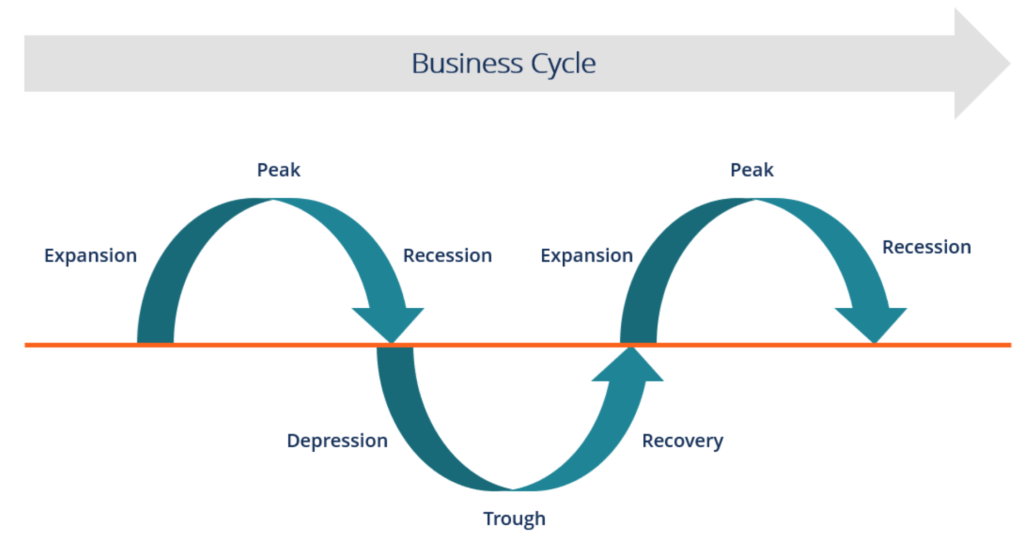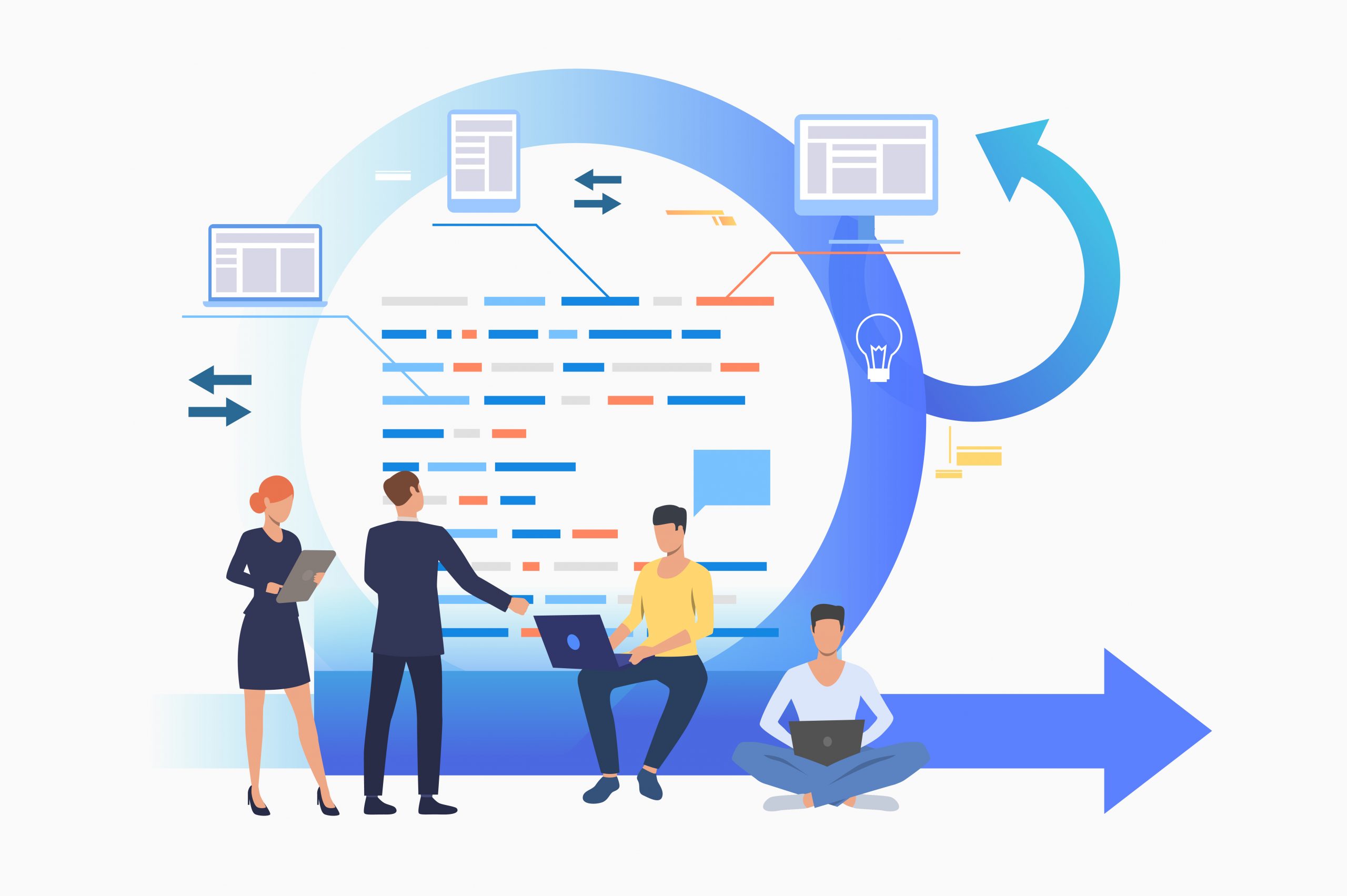Share:
What are business cycles?
Business cycles refer to the fluctuations in economic activity characterized by periods of growth and contraction. They are characterized by gross domestic product (GDP) changes, employment, and prices. Business cycles are a normal part of the market economy and can last for several years. During expansionary phases, the economy grows, employment rises, and prices tend to increase. During recessionary phases, the economy contracts, employment falls, and prices tend to decrease. Understanding and anticipating business cycles can help businesses make better decisions and policymakers develop effective economic policies. Corporate finance institute submits 6 main business cycle steps – expansion, peak, recession, expansion, peak, recession. Other three steps – depression, trough, and recovery – submit a negative side and downturn of the business cycle.

Business cycles typically follow a pattern of four distinct stages: expansion, peak, contraction, and trough. During the expansion stage, the economy experiences growth in economic activity, rising employment, and increased consumer spending. The peak marks the end of the expansion and the beginning of the contraction phase, characterized by slowing economic growth and declining employment. The contraction phase is characterized by a decrease in economic activity, declining employment, and decreasing consumer spending. The trough marks the end of the contraction and the beginning of the expansion phase, starting the cycle anew. Business cycles are not always predictable and can vary in length, severity, and timing.
How to measure it?
Business cycles are measured using various economic indicators, such as:
- Gross Domestic Product (GDP): The total value of goods and services produced within a country’s borders.
- Unemployment Rate: The percentage of the labor force that is without a job but actively seeking employment.
- Industrial Production: A measure of the output of factories, mines, and utilities.
- Retail Sales: A measure of the total value of sales at the retail level.
- Consumer Price Index (CPI): A measure of the average change over time in the prices paid by consumers for a basket of goods and services.
- Housing Starts: A measure of the number of new homes being built.
- Stock Market Indicators: Changes in stock market indices such as the S&P 500 or the Dow Jones Industrial Average can also be used to track business cycles.
These indicators are used in combination to track the overall state of the economy and determine where it is in the business cycle.
What factors shape business cycles?
Business cycles are shaped by various internal and external factors. Internal factors include consumer and business confidence, changes in government policies and regulations, and shifts in demographics and consumer behavior.
External factors include global economic conditions, changes in trade policies, natural disasters, and geopolitical events. Technological innovations, resource constraints, and shifts in energy prices can also play a role in shaping business cycles. Additionally, monetary policies, such as changes in interest rates and the money supply, can impact the economy and contribute to the shape of business cycles. A complex interplay of these various factors ultimately determines the path of the business cycle.
How it affects business decisions?
Business cycles can greatly affect business decisions. Understanding where the economy is in the business cycle can help businesses make informed decisions about investment, hiring, and production. For example, during an expansionary phase, businesses may increase investment in new projects, expand their operations, and hire more employees. Conversely, during a recessionary economic cycle phase, businesses may cut back on investment, reduce production, and lay off workers. Businesses may also alter their pricing strategies based on the state of the economy, such as lowering prices during a recession to maintain sales. By being aware of the business cycle, businesses can make better decisions, improve their competitiveness, and increase their growth rate and chances of success.
Changes in the business cycle are primarily caused by four factors: business decisions, interest rates, consumer expectations, and external problems. Businesses that expand production contribute to an expansion by boosting the overall supply. When they cut back on manufacturing, supply also goes down, which could lead to a contraction. When interest rates increase, both firms and consumers are less likely to borrow money to make purchases, which slows the economy. Lower interest rates make loans more affordable and increase the likelihood of an economic expansion. The level of consumer spending, a key driver of aggregate demand, is influenced by how people feel about the state of the economy. External factors, such as calamities or wars abroad, might occasionally have an impact on the overall supply.
Leverage your business cycle decisions with isLucid
isLucid meeting management platform allows its users to leverage business decisions through the online meetings space. isLucid gives its users an opportunity to manage their online meetings in the easiest way possible. Meeting information management software provides real-time transcription, and enables users to create tasks and meeting minutes within a single click. Information is being transferred to preferred project management software, CRM, or ATS. You can create meeting agenda and bookmark important notes from the online meeting. Meeting transcript files can be uploaded from different online meeting platforms (Microsoft Teams, Google Meets, Zoom). People are informed about the tasks or shared meeting minutes.
isLucid meeting information management platform brings its users an opportunity to have all of their generated meeting transcript files securely stored in one place.
If you are interested in isLucid digital meeting assistant, you can try it for free: isLucid Download Page
You can also book a demo and get a walkthrough: Book a Demo

